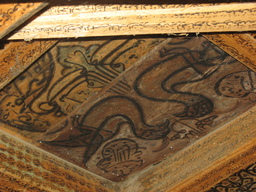
Mazar of Pir Sayyid Farukh Shah
 Mazar of Pir Sayyid Farukh Shah |
Friederike and I happened by the Khorog museum yesterday. It was not only small, but also disappointing in many ways typical for Soviet-constructed museums. Descriptions of objects--where they existed--were all written in Russian. A docent followed along as we walked through, turning the lights of each room off as we exited, then turning the lights of the next room on as we entered. The collection was junky, including stacks of old newspapers and magazines. At one point we entered a large room that was entirely empty, save for posters along the walls.
We went in and sat down on the floor, more out of a desire to rest our legs than to appreciate whatever was lining the walls. This time, the docent didn't follow us in but stood out in the corridor, fixated on the screen of her mobile phone. I glanced up at the posters.
"Oh. These are pictures of shrines around Tajikistan. How can they call some bunch of old posters an exhibition?", I asked rhetorically.
As we rested, I noticed one poster not far from where we were seated. Most of the others showed exterior shots of shrines with plain, blocky architecture. None of those structures seemed ornate enough to warrant a closer look: I'd seen far grander constructions around Uzbekistan and Iran. However, this sole poster showed calligraphy gracing wooden support beams along the interior of some building. Even seeing a crude lithograph from afar I could tell that the calligraphy was very good. The letters forming passages of Arabic text were scripted perfectly. Rarer--and absolutely beautiful--were images of birds and lions formed wholly from calligraphic letters.
"Which shrine is that? Where is it? We really have to find this place," I declared upon scrutinizing the poster.
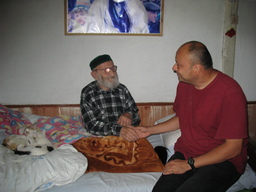 David and Caliph Shohi Kalon |
Mazar of Pir Sayyid Farukh Shah
Saroi Bahor
Khushk, Shughnon, Badakhshan
That evening we spoke with a local tour guide. He had come to the jamaat-khana for the evening service; we happened to strike a conversation up while taking dinner outside. I brought up the subject of the shrine. The news could have been good: he said that he could take us to the shrine the next afternoon. However, I was dubious. He didn't speak English; what we could say in Tajik was limited. It didn't seem clear that he truly knew that particular village--let alone the shrine we wanted to find. And--hospitable as people are here in the Pamirs--it all seemed too convenient. He said that he "just happened" to be driving out that way the very next day so could take us for a low price. But, when communication became less fluid over exactly how much a ride for two might cost, I figured we should find an alternate way to locate the calligraphy.
So, this morning we started asking around to track down just where the shrine might be on our own. Perhaps there might be some local bus that could take us out to the town named on the poster. Deciphering the text Friederike had copied down didn't offer much direction, though. All of eastern Tajikistan is Badakhshan. I knew that the language spoken here in Khorog is Shughnoni--so hoped the shrine might be somewhere not too far from the city. However, none of our maps showed any town called Kushk.
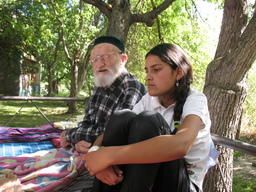 Shohi Kalon and Sabrina |
Then, the perfect person came to our rescue. A Pamiri woman with perfect English walked up and asked us what we trying to say to the staff. By that point we'd already given up on getting any further details on the shrine's location. We were just trying to ask--in our broken Tajik--how much they wanted us to pay for our lodging and the breakfast we had just eaten. "They say the total comes to whatever you feel like giving," she translated.
After we'd settled the tab, I asked this woman with good English--Saheli--if she'd ever heard of this particular shrine or town. She had no idea, herself. But she was free for the day and up for an adventure.
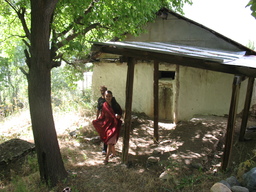 Saheli and Rahman outside the Shrine |
The village was close: only about half an hour's drive from Khorog. There was no way Friederike and I would have been able to find it on our own. It was a mere spot up the side of a hill.
After we arrived into town we found that nobody was quite sure where we wanted to go. We were directed to the house of the village caliph, Shohi Kalon. I think we interrupted his afternoon nap. We were invited into a central room where he was lying on a bed next to a pair of snoozing kittens. Shohi Kalon was 89 years old and looked every bit of it.
Our three Ismaili traveling companions found this chance encounter to be an act of amazing serendipity. Rahman had been introduced to this caliph once before, on his last visit to Tajikistan. They spoke animatedly about the Aga Khan and life in the Pamirs. Sabrina sat down on the bed next to the caliph, holding his hand and respectfully addressing him as "Baba". Saheli translated; I felt embarrassed by the basic nature of my questions to a man who clearly held a high religious position.
When we finally got around to the topic at-hand, the caliph couldn't help us.
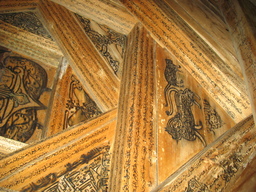 Beams of Shrine Ceiling |
I was crestfallen. I thought that if anybody could help us find the shrine from the museum poster, surely an 89-year old local caliph would be the right man.
People looked again and again at the text that Friederike had written but nobody seemed to know where the shrine was. I tried framing the question from a different approach:
"Is there anywhere in this village that has a shrine, or any sort of structure with nice calligraphy?", I asked Shohi Kalon. Saheli translated.
The caliph thought for a long while before answering. "Well, there's my grandfather's tomb. We'll have to get the local teacher to unlock the front door if you want to look inside. He's the one who keeps the keys."
After some minutes a man came to the house. He escorted us through the trails of the small village. We were led to a plain white one-storey building. There was no sign or other marker indicating what lay inside.
The teacher unlocked the door and we stepped in. In the center of the floor we first saw two plain cement slabs. Then we looked up at the ceiling. We'd found the right shrine.
Below are additional details about the shrine that weren't printed on the poster. Thanks to Caliph Shohi Kalon and Saheli for their help providing these details and helping us to locate the shrine.
Saroi Dilruba (Saroi Bahor)
Gumbadi Farukhshoh (grandfather of Shohi Kalon)